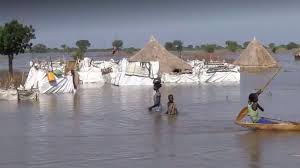South Sudan’s seasonal flooding, once a predictable part of life, has become an annual catastrophe, displacing hundreds of thousands of people and plunging communities deeper into crisis.
Families like that of Nyabuot Reat Kuor, a mother displaced from her home in Gorwai, bear the brunt of the climate disaster.
“When we were in Gorwai, there was too much flooding. It destroyed our farm and displaced us for good,” Nyabuot said. “We don’t know what caused this flooding, but it destroyed our land and killed our livestock. When we were displaced from our home, we only had wild plants to eat.”
Nyabuot now lives with her family along the Jonglei Canal, a century-old, unfinished waterway that has become a lifeline for over 69,000 displaced people in Ayod County.
Villagers survive on food assistance from the World Food Programme (WFP), wild plants, and water lilies from the swamp when aid runs out.
According to the U.N. humanitarian agency, more than 379,000 people have been displaced by flooding this year alone.
South Sudan, described by the World Bank as the world’s most vulnerable country to climate change, is poorly equipped to cope.
Infrastructure is crumbling, and years of civil war have left the government unable to address crises like flooding, which continues to submerge villages, destroy farmland, and kill livestock.
Aid Delivered by Air
The displaced communities in Ayod County are almost entirely cut off from the outside world.
Roads are impassable, and canals are too shallow for boats carrying food. Aid must arrive by air.
“We actually deliver food by airdrops,” said John Kimemia, a WFP airdrop coordinator. “Before delivering, we have to prepare the ground for a drop zone. In this case, the area didn’t have a clear drop zone, so we have to get the help of the community to clear it. There’s no access at this time by road or by boat from the canal.”
Despite the WFP’s efforts, resources are stretched thin.
Food aid rations have been halved in recent years due to dwindling international funding.
When assistance runs out, displaced families are left with no choice but to forage.
Survival Amid Isolation
The isolation of these communities deepens their challenges.
In the village of Pajiek, Ayod’s county headquarters is only reachable by a six-hour walk through waist-high water.
There is no mobile network, no government presence, and no regular healthcare access.
At the Paguong village health center, surrounded by flooded lands, medics haven’t been paid since June.
Patients, mostly women and children, wait on the ground for treatment amid fears of venomous snakes in the area.
South Sudan’s economic woes have only worsened as a damaged oil pipeline in neighboring Sudan, caused by its ongoing civil war, disrupts exports. Civil servants across the country have gone unpaid for over a year.
Climate and Conflict
The repeated flooding has been linked to factors such as the opening of dams upstream in Uganda and rising levels in Lake Victoria.
South Sudan’s wetlands, the Sudd, have expanded dramatically since the 1960s, submerging more land and displacing more people.
As the crisis worsens, the unfinished Jonglei Canal—a colonial-era project to divert water north to Egypt—has become a refuge for families seeking higher ground.
But for displaced people like Nyabuot Reat Kuor, life remains precarious. “We survive on what we can find,” she said. “Wild plants, water lilies. We just want food and help to live.”
South Sudan’s flooding is not only a climate disaster but a humanitarian emergency, exposing the fragility of a nation grappling with conflict, poverty, and climate vulnerability.
For Nyabuot and thousands of others, survival hangs by a thread.
Africanews/Hauwa M.


Comments are closed.